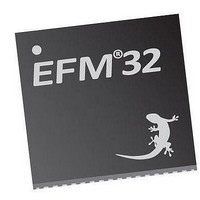EFM32TG210F32 Energy Micro, EFM32TG210F32 Datasheet - Page 305

EFM32TG210F32
Manufacturer Part Number
EFM32TG210F32
Description
MCU 32BIT 32KB FLASH 32-QFN
Manufacturer
Energy Micro
Series
Tiny Geckor
Specifications of EFM32TG210F32
Core Processor
ARM® Cortex-M3™
Core Size
32-Bit
Speed
32MHz
Connectivity
EBI/EMI, I²C, IrDA, SmartCard, SPI, UART/USART
Peripherals
Brown-out Detect/Reset, DMA, POR, PWM, WDT
Number Of I /o
24
Program Memory Size
32KB (32K x 8)
Program Memory Type
FLASH
Ram Size
4K x 8
Voltage - Supply (vcc/vdd)
1.8 V ~ 3.8 V
Data Converters
A/D 4x12b, D/A 1x12b
Oscillator Type
External
Operating Temperature
-40°C ~ 85°C
Package / Case
32-VQFN Exposed Pad
Processor Series
EFM32
Core
ARM Cortex-M3
Data Bus Width
32 bit
Data Ram Size
32 KB
Interface Type
UART, I2C, SPI
Maximum Clock Frequency
32 MHz
Number Of Programmable I/os
17
Number Of Timers
1
Operating Supply Voltage
1.8 V to 3.8 V
Maximum Operating Temperature
+ 85 C
Mounting Style
SMD/SMT
Processor To Be Evaluated
EFM32TG210
Lead Free Status / RoHS Status
Lead free / RoHS Compliant
Eeprom Size
-
Lead Free Status / Rohs Status
Details
- Current page: 305 of 522
- Download datasheet (9Mb)
20.3.2 Hysteresis
20.3.3 Auxillary counter
2010-12-21 - d0034_Rev0.90
The direction of the quadrature code and control of the counter is generated by the simple binary function
outlined by Table 20.1 (p. 305) . Note that this function also filters some invalid inputs that may occur
when the shaft changes direction or temporarily toggles direction.
Table 20.1. PCNT QUAD Mode Counter Control Function
Note
By default the pulse counter wraps to 0 when passing the configured top value, and wraps to the top
value when counting down from 0. On these events, a system will likely want to wake up to store and
track the overflow count. This is fine if the pulse counter is tracking a monotonic value or a value that
does not change directions frequently. If you have the latter however, and the counter changes directions
around the overflow/underflow point, the system will have to wake up a lot to keep track of the rotations,
causing high current consumptions
To solve this, the pulse counter has a way of introducing hysteresis to the counter. When HYST in
PCNTn_CTRL is set, the pulse counter will always wrap to TOP/2 on underflows and overflows. This
takes the counter away from the area where it might overflow or underflow, removing the problem.
Given a starting value of 0 for the counter, the absolute count value when hysteresis is enabled can
be calculated with the equations Equation 20.1 (p. 305) or Equation 20.2 (p. 305) , depending on
whether the TOP value is even or odd.
Absolute position with hysteresis and even TOP value
Absolute position with hysteresis and odd TOP value
To be able to keep explicit track of counting in one direction in addition to the regular counter which
counts both up and down, the auxillary counter can be used. The pulse counter can for instance be
configured to keep track of the absolute rotation of the wheel, and at the same time the auxillary counter
kan keep track of how much the wheel has reversed.
The auxillary counter is enabled by configuring AUXCNTEV in PCNTn_CTRL. It will always count up,
but it can be configured whether it should count up on up-events, down-events or both, keeping track
of rotation either way or general movement. The value of the auxillary counter can be read from the
PCNTn_AUXCNT register.
Overflows on the auxillary counter happen when the auxillary counter passes the top value of the pulse
counter, configured in PCNTn_TOP. In that event, the AUXOF interrupt flag is set, and the auxillary
counter wraps to 0.
Inputs
S1IN posedge
0
0
1
1
PCNTn_S1IN is sampled on both edges of PCNTn_S0IN.
CNT
CNT
abs
abs
= CNT - UF
= CNT - UF
S1IN negedge
0
1
0
1
CNT
CNT
x (TOP/2+1) + OF
x (TOP/2+1) + OF
...the world's most energy friendly microcontrollers
305
Control/Status
Count Enable
0
1
1
0
CNT
CNT
x (TOP/2+1)
x (TOP/2+2)
CNTDIR status bit
0
0
1
0
www.energymicro.com
(20.1)
(20.2)
Related parts for EFM32TG210F32
Image
Part Number
Description
Manufacturer
Datasheet
Request
R

Part Number:
Description:
KIT STARTER EFM32 GECKO
Manufacturer:
Energy Micro
Datasheet:

Part Number:
Description:
KIT DEV EFM32 GECKO LCD SUPPORT
Manufacturer:
Energy Micro
Datasheet:

Part Number:
Description:
BOARD PROTOTYPING FOR EFM32
Manufacturer:
Energy Micro
Datasheet:

Part Number:
Description:
KIT DEVELOPMENT EFM32 GECKO
Manufacturer:
Energy Micro
Datasheet:

Part Number:
Description:
MCU, MPU & DSP Development Tools TG840 Sample Kit
Manufacturer:
Energy Micro
Datasheet:

Part Number:
Description:
MCU, MPU & DSP Development Tools TG Starter Kit
Manufacturer:
Energy Micro
Datasheet:

Part Number:
Description:
MCU, MPU & DSP Development Tools TG108 Sample Kit
Manufacturer:
Energy Micro

Part Number:
Description:
MCU, MPU & DSP Development Tools TG210 Sample Kit
Manufacturer:
Energy Micro
Datasheet:

Part Number:
Description:
MCU, MPU & DSP Development Tools TG822 Sample Kit
Manufacturer:
Energy Micro
Datasheet:

Part Number:
Description:
MCU, MPU & DSP Development Tools TG230 Sample Kit
Manufacturer:
Energy Micro

Part Number:
Description:
SAMPLE KIT (SMALL BOX - CONTAINING 2 DEVICES)
Manufacturer:
Energy Micro

Part Number:
Description:
SAMPLE KIT (SMALL BOX - CONTAINING 2 DEVICES)
Manufacturer:
Energy Micro










